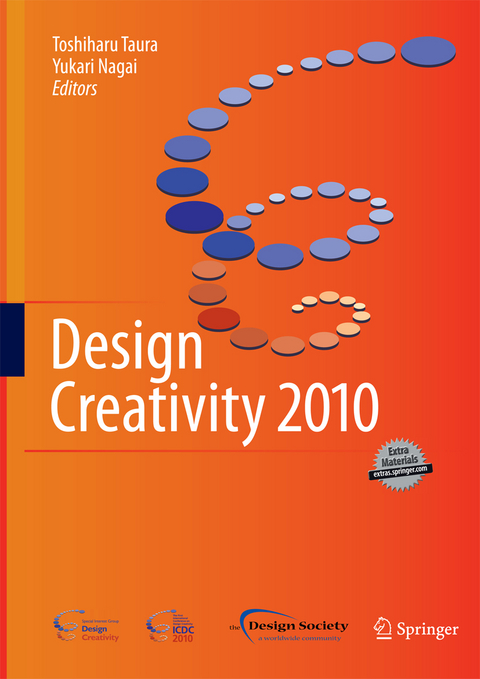
Design Creativity 2010
Springer London Ltd (Verlag)
978-1-4471-6095-3 (ISBN)
What is ‘design creativity’? It is impossible to answer this question without considering why human beings can – and do – ‘design’. Design creativity is instrumental in not only addressing social problems faced across the world, but also evoking an innate appreciation for beauty and a sense of personal contentment.
Design Creativity 2010 comprises advanced research findings on design creativity and perspectives on future directions of design creativity research. The papers included were presented and discussed at the first ICDC (International Conference on Design Creativity), which was held at Kobe, Japan, in 2010. Design Creativity 2010 encourages readers to enhance and expand their activities in the field of design creativity.
Toshiharu Taura is Professor of Graduate School of Engineering at Kobe University. He received his B.S., M.S., and Dr. Eng. degrees from the University of Tokyo, Japan, in 1977, 1979, and 1991, respectively. In 1992, he joined the University of Tokyo as an Associate Professor, and in 1998, he joined Kobe University as Professor at the Mechanical Engineering Department. He is currently working on several research themes that focus on the creative thought process of both engineering and industrial design, including the interdisciplinary aspects of design science. He is a member of the Advisory Board, is heading the Design Creativity SIG of the Design Society and a Fellow of the DRS (Design Research Society). He is the recipient of the Best Paper Prize at the 2nd International Conference on Design Computing and Cognition (2006), as well as some domestic awards. Yukari Nagai is Associate Professor of Graduate School of Knowledge Science at Japan Advanced Institute of Science and Technology since 2004. She graduated from Musashino Art University, majored in Design (M.A), and researched abroad at Creativity and Cognition Research Studios, Loughborough University (2002). She received PhDs from Chiba University (2003), and University of Technology, Sydney (2009). Best Paper Prize was awarded to her at DESIGN2002 Conference and International Conference on Design Computing and Cognition (2006). She is a member of the Design Society and a co-chair of SIG Design Creativity. She has served as an editorial board member of the Journal of Engineering Design, and contributed as guest editor of special issue of journal “Artifact” (2008). Her research interests are design creativity, design knowledge and creative cognition.
Discussion on Direction of Design Creativity Research (Part 1) - New Definition of Design and Creativity: Beyond the Problem-Solving Paradigm.- Discussion on Direction of Design Creativity Research (Part 2) - Research Issues and Methodologies: From the Viewpoint of Deep Feelings and Desirable Figure.- Future Directions for Design Creativity Research.- Systematic Procedures Supporting Creativity - A Contradiction?.- Better, Not Catchier: Design Creativity Research in the Service of Value.- Using Evolved Analogies to Overcome Creative Design Fixation.- Design Creativity Research: From the Individual to the Crowd.- Motivation as a Major Direction for Design Creativity Research.- Design Research and Designing: The Synergy and The Team.- Not from Scratch: The DMS Model of Design Creativity.- Influence of Environmental Information on Expert-perceived Creativity of Ideas.- Towards a New Theory for Design Activity Reasoning.- An Approach to Measuring Metaphoricity of Creative Design.- Interrelations between Motivation, Creativity and Emotions in Design Thinking Processes – An Empirical Study Based on Regulatory Focus Theory.- Conceptual Design and Cognitive Elements of Creativity: Toward Personalized Learning Supports for Design Creativity.- DANE: Fostering Creativity in and through Biologically Inspired Design.- Development of a Catalogue of Physical Laws and Effects Using SAPPhIRE Model.- Measuring Semantic and Emotional Responses to Bio-inspired Design.- Design of Emotional and Creative Motion by Focusing on Rhythmic Features.- Create Adaptive Systems through “DNA” Guided Cellular Formation.- Developing a Coding Scheme to Analyse Creativity in Highly-constrained Design Activities.- Effectiveness of Brainwriting Techniques: Comparing Nominal Groups to Real Teams.- Front End Industrial Design (FE-ID) - Developing New Tools and Models for Industrial Designers to Operate at the Front End of New Product Development.- Virtuality – Offering Opportunities forCreativity?.- Thinking Inside the Box: Model, Tool, Team and Setting for Building Design.- Signs of Collaborative Ideation and the Hybrid Ideation Space.- Creativity: Depth and Breadth.- Research Methodology for the Internal Observation of Design Thinking through the Creative Self-formation Process.- Design as a Perception-in-Action Process.- Verbal Stimuli in Design Creativity: A Case-study with Japanese Sound-symbolic Words.- Creative Collaborative Strategies of Remote Sketching on Design.- Creation of New Fashion Illustration Painting Techniques by Use of India-ink Painting Techniques: Research into Line Drawing Techniques of Expression in Fashion Illustrations.- How Uncertainty Helps Sketch Interpretation in a Design Task.- The Complementary Role of Representations in Design Creativity: Sketches and Models.- A Creativity Environment for Educational Engineering Projects when Developing an Innovative Product: A Case Study.- The Metaphor of an Ensemble: Design Creativity as Skill Integration.- Coaching the Cognitive Processes of Inventive Problem Solving with a Computer.- Creative Engineering Design Aspects given in a Creativity Training Course.- Differential Approach of Design Image and Similarity Cognition.- Poetry and Design: Disparate Domains but Similar Processes.- Design by Customer: a Management of Flexibilities.
| Erscheint lt. Verlag | 21.8.2014 |
|---|---|
| Zusatzinfo | XIII, 330 p. |
| Verlagsort | England |
| Sprache | englisch |
| Maße | 210 x 297 mm |
| Themenwelt | Kunst / Musik / Theater ► Design / Innenarchitektur / Mode |
| Kunst / Musik / Theater ► Kunstgeschichte / Kunststile | |
| Informatik ► Weitere Themen ► CAD-Programme | |
| Technik ► Architektur | |
| Technik ► Maschinenbau | |
| ISBN-10 | 1-4471-6095-9 / 1447160959 |
| ISBN-13 | 978-1-4471-6095-3 / 9781447160953 |
| Zustand | Neuware |
| Haben Sie eine Frage zum Produkt? |
aus dem Bereich


